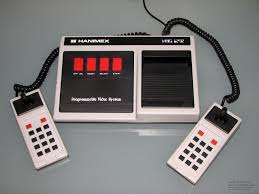In the period somewhere beyond your stepchild’s read-and-write phase, and definitely prior to their leaving home, brace yourself for the onset of something even more pervasive than this child’s disdain for your cooking.
The world of gaming.
My experience of childhood gaming was gained at the joystick of a Hanimex game console. Right up there with the gut-wrenching deprivation associated with never having a clutch of legit Barbies was the ignominy of being deprived of the #1 console of the 1970s – the Atari. My request to Santa that year had clearly been light on specifics and instead of receiving the now-iconic console with its nearly-real woodgrain that contrasted stylishly with its hulking black cover, robust joystick and options managed by six schmicky switches, our household was gifted with its less-salubrious cousin, the Hanimex 1292.

We stifled our disappointment in this brand-name fail and then enthusiastically devoted countless hours to conquering rows of alien creatures from a single warlike token (crafted long before the term ‘avatar’ even existed), constrained as it was to only moving horizontally, with diminishing cover from eminently-penetrable blocks that served as barracks. Standard also with the console was the ‘Olympics’ which delivered further games that were variations on the theme of a geometric shape addressing a moving object.
However, you might be unsurprised to know that a misspent youth involving a 1978 Hanimex, toting its 32 colours and whopping 43 bytes of data memory is in no way adequate preparation for modern-era gaming.
Having embraced that learning curve, here’s what I found:
It’s how kids play together today
If your childhood, like mine, consisted of in-person social activities, where you’d cycle helmet-less a couple of streets over to a mates house to play make-believe games, you’d be staggered to find that today’s teen need not be in the same house or even the same continent to play together.

Instead they are all decked out in headsets that allow them to communicate with all the other player with all the swagger of the (first-generation, 1980s) Maverick in Top Gun. Despite the chasm of several decades, the focus on elaborate call signs, inexplicable lingo and the ability for escalation into shouty-ness seems uncannily common to both Top Gun and Fortnite.
In some ways, the social aspect is vaguely reassuring. It would appear that gaming is now not reserved for those geeky, loner kids you observed honing their first-person shooter skills in Doom, handwriting their manifesto in a jotter pad and, if they were in the US, lurching worryingly close to taking their skills into the classroom.
The expense
In today’s gaming universe, there is no concept of buying a console and expecting this to be a comprehensive package of everything that is required to keep a kid entertained. It’s like the next-level mismatch in expectations that came with your Barbie Treehouse if you didn’t read the fine-print that said *accessories not included.
If you would like your stepchild to be spared the status of social pariah, they will also need:
- A PC with the level of grunt that only two years ago would have been sufficient to run a major financial institution’s data centre.
- A mouse that cost more than your favourite pair of wedges
- A gaming keyboard that you can be assured will NEVER feature in the back-to-school specials at Officeworks.
And this my friends, is only the hardware.
In-game purchases are required to keep a child’s head above the competitive-gaming water. Beyond the almost-logical idea of purchasing useful weapons and tools rather than having to fight other children for them in the actual game is the inexplicable concept of paying money for clothing for your avatar. Clothing. Full outfits. Accessories.

While I’m all about the joy of augmenting your wardrobe via online purchases, I feel like an essential element of this experience is the arrival of a package, containing something that you can actually wear in real-life. If the purchase had taken place under the influence of a few too many sauvignon blancs on a Friday night, there’s the added element of surprise.
If I was inclined to tote up these things, I’d be certain that our household’s expenditure on gaming-related paraphernalia in the last two years is on par with the investment in my first car. Admittedly, the purchase of a 1975 Torana in the late 80s is probably modest by today’s standards, but if that brown-and-beige beast were still around today it would fetch a tidy price amongst the Holden aficionados. By contrast, our last two X-Boxes serve no apparent purpose other than their annual role as props for the one wonky leg of the Christmas tree.
Investment of time
I know that it’s easy to lose yourself in the world of gaming. Even the modest functionality offered by the 1970s Hanimex was a time-suck. The makers of the first generation Donkey Kong underestimated the attention span of a child, providing a scoreboard with one less digit than was necessary to thwart the user’s relentless quest to ‘clock’ the game – so we all just kept going.
Current gaming goes way beyond this. Infinite numbers of levels within a game. The ability to simply offer a new version digitally, with a dizzying array of new features, without the need for anyone to schlepp into the local games shop and buy a new version. Today’s gaming creators would scoff at rookie tactics like the lights and sounds of pokies and clock-free / window-less casinos as temptation to lose hours of your time (and possibly custody of your children if you left them in the car in the casino car park.) They’ve discovered artful ways to target the neural centres of the brain that govern reward systems and ways to fiddle with your dopamine.
All this means your stepchild is not going to want to leave their extortionately-priced gaming chair anytime soon. If your household is prone to the somewhat elastic boundaries that are a common feature of the Disney Dad, the general philosophy of ‘what’s the harm?’ may prevail. The upside of this is that you are free to see a movie, indulge at the day spa or get through an entire paperback without the guilt of dodging real-life, outdoorsy kid activities that if you are in the earnest early years of stepmother-hood you might feel otherwise compelled to join.
The upside
Today’s games do apparently contribute some benefits. There is clear link to the development of hand-eye co-ordination, visual-spatial ability and reaction time. When, in an attempt at relevance, I tried to dabble in Fortnite, I quickly discovered these traits distinctly lacking, to the extent that I managed to architect my own demise, not at the hands of one of my 99 armed foes, but by falling off a building. It’s unclear whether this is the result of inadequate stimulation in my youth at the hands of our simplistic Hanimex or a more recent gradual erosion of brain cells due to a long love affair with a chilled glass of white wine.
So your stepchild will acquire some life skills, whether they are the fine motor skills that may signal success as a surgeon or the ability to accumulate power, wealth and weapons in preparation for the role of dictator of a small country.
On the other hand, if you want to stimulate some old-school 1970s resilience, try presenting them with last-year’s console that you got for free on e-Bay and see how long it takes before there are tears.

